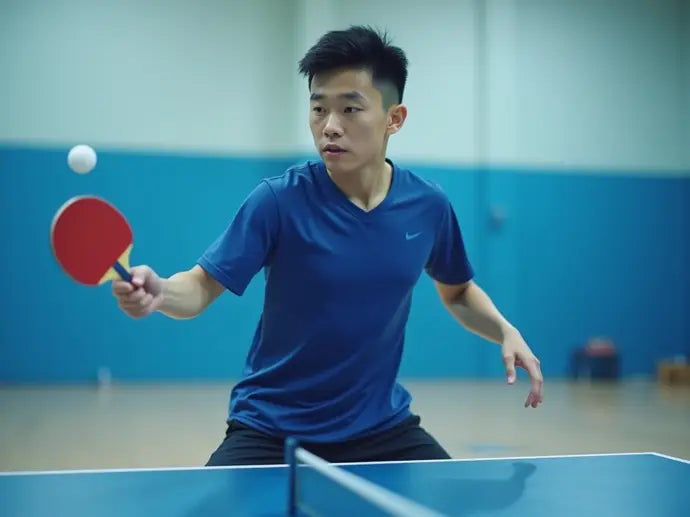4 Must-Know Table Tennis Shots to Master for Every Aspiring Player

If you are reading this, you must be an intermediate or beginner who is looking to improve your table tennis skills and compete at a higher level; learning the fancy strokes comes later. The truth is, even experienced players rely heavily on brushing up the fundamentals—strokes that improve consistency, control, and tactical advantage.
Whether you’re a beginner or someone stuck at an intermediate level, mastering the four basic shots outlined is very crucial to improving your performance throughout the game. This guide is not only for beginners; as mentioned, it's meant for table tennis players who are looking to strengthen the foundation on which advanced tactics are built. Let’s break them down one by one.
1. The Forehand Drive – Establish Your Offensive Foundation
The forehand drive is one of the first strokes taught to every table tennis player. The forehand drive shot is meant for fast, controlled, topspin-oriented game play between mid-range rallies.
Why it matters
The forehand drive teaches players how to generate topspin and power without overhitting. When performed correctly, it puts your opponent on the defensive and keeps you in control of the point.
How to do it
-
The stance must be feet shoulder-width apart, with knees slightly bent.
-
Make use of a relaxed shakehand or penhold grip to achieve.
-
Rotate your torso slightly, bring the paddle back waist-high, and swing forward with a brushing motion across the ball.
-
Aim to strike the ball at its highest point, just after the bounce.
Pro tip: Focus on balance and timing. A rushed forehand drive usually ends up in the net or off the table. Practicing this with a robot or multiball drills can develop consistency and confidence.
2. The Backhand Drive – Balance and Quick Reaction
While many players initially favor their forehand drive, and continue their Table Tennis journey with just learning one shot. But playing backhand drive adds power and control to your game. Most of the ITTF approved Table tennis blades welcome backhand drive as they are curated for players who master all these shots.
Why it matters
Many recreational players lack a solid backhand. Developing this shot early helps you win fast-paced rallies and close the gap when pulled out of position.
How to do it
-
Make sure the stance is perfect as mentioned, stand square to the table, with your paddle just in front of your chest.
-
Pivot from your elbow while maintaining a compact motion. Avoid swinging too wide.
-
Keep the paddle slightly angled inward or closed and brush the ball gently for light topspin.
-
Strike the ball only when it reaches the peak of bounce.
Pro tip: The backhand drive isn’t just a defensive shot — it's a tool for setting up aggressive rallies and countering short pushes. Practice with cross-table drills to improve accuracy under pressure.
3. The Push – Mastering the Defensive Game
If you want to give a competitive play, mastering the push shot is important. This backspin-heavy shot is purely curated to return low and short balls while reducing opponent’s offensive potential.
Why it matters
The push keeps the ball low and can even balance the forced errors when placed well.
How to do it
-
Paddle angle must straight open your paddle (facing slightly up).
-
Smooth motion is required, the TT blade is swung downward-forward motion to slice the bottom of the ball.
-
Strike the bottom part of the ball to induce spin and keep it low over the net.
-
Stay low, with bent knees and a stable stance.
Types of pushes
Short push: Lands just across net, great for controlling pace.
Long push: Goes deep to the backhand or body, often used to provoke an attack.
Pro tip: The push isn’t passive — vary your spin and placement to turn this stroke into a tactical weapon.
4. The Serve – Control the Start of Every Rally
Being the first move of a rally serving is the only part of table tennis where the player will have complete control of the rally. A powerful serve can give you a direct advantage by setting up your score outright through deception and spin.
Why it matters
Serve is one of the crucial At all levels of play, the serve can dictate who controls the rally. Players who rely on predictable or easy-to-read serves will often find themselves defending from the get-go.
How to do it
-
The ball must be tossed at least 6 inches upward and struck behind the end line.
-
Learn to generate different types of spin — backspin, topspin, sidespin, and combinations of them.
-
Varying where your serve lands can break your opponent’s rhythm. Try short serves to the forehand or long, fast ones to the backhand.
-
Use similar paddle motions for different spins to confuse your opponent.
Types of effective serves to practice
Pendulum serve: A go-to for sidespin and backspin combinations.
Reverse pendulum serve: Spins in the opposite direction and is great for disrupting opponents used to the standard pendulum.
Tomahawk serve: A unique motion that can surprise unprepared players.
Pro tip: Spend at least 15 minutes per session just practicing your serve. It’s an investment that pays off every match.
Conclusion: Master the Basics, Elevate Your Game
Every elite player — even the pros you watch on YouTube — started with these basic four shots: the forehand drive, backhand drive, push, and serve. No matter your level, refining these strokes gives you the tools to build real skill, strategy, and consistency.



